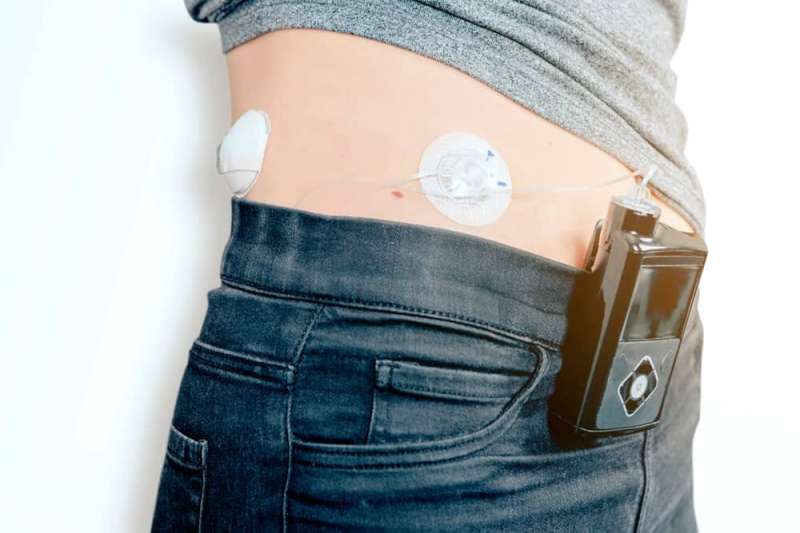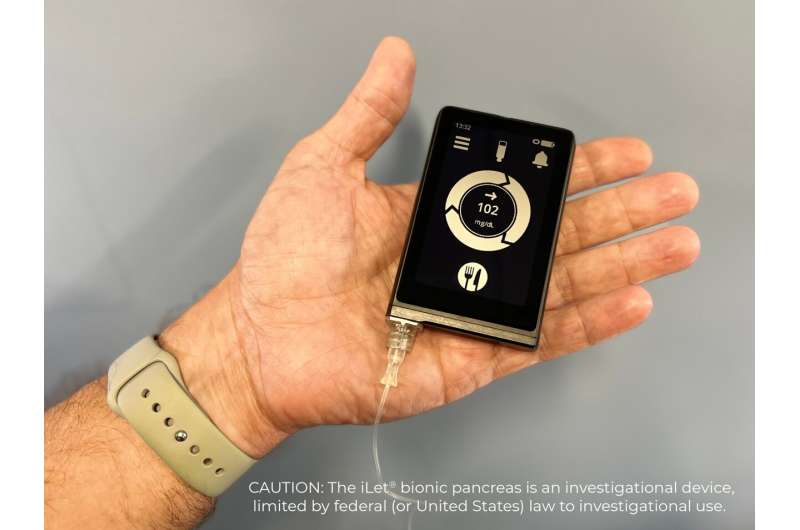Clinical trial shows bionic pancreas improves type 1 diabetes management compared to standard insulin delivery method

A device known as a bionic pancreas, which uses next-generation technology to automatically deliver insulin, was more effective at maintaining blood glucose (sugar) levels within normal range than standard-of-care management among people with type 1 diabetes, a new multicenter clinical trial has found. The trial, conducted partly at Nemours Children's Health, Jacksonville, was published in the New England Journal of Medicine.
Automated insulin delivery systems, also called artificial pancreas or closed-loop control systems, track a person's blood glucose levels using a continuous glucose monitor and automatically deliver the hormone insulin when needed, using an insulin pump. These systems replace reliance on testing glucose levels by fingerstick, a continuous glucose monitor with insulin delivery through multiple daily injections, or a pump without automation.
Compared to other available artificial pancreas technologies, the bionic pancreas requires less user input and provides more automation because its algorithms continually adjust insulin doses automatically based on users' needs. Users initialize the bionic pancreas by entering their body weight into the device's dosing software at the time of first use.
Users of the bionic pancreas do not have to count carbohydrates, nor initiate doses of insulin to correct for high blood glucose. In addition, health care providers do not need to make periodic adjustments to the device settings.

Nemours Children's Health, Jacksonville is one of 16 U.S. institutions that participated in the study. It is a certified Center of Excellence by the American Diabetes Association and brings world-class medical, academic, and research collaborations to Northeast Florida. One of the study's principal investigators, Nelly Mauras, MD, is a career clinical research scientist in pediatric endocrinology and diabetology, director of research and vice chair of pediatrics at Nemours Children's Health, Jacksonville, as well as a professor of pediatrics at Mayo Clinic College of Medicine.
"Our study shows that the advanced bionic pancreas technology managed blood glucose better than currently available insulin delivery methods among participants of all ages, from adults to children as young as six years old," said Dr. Mauras. "This is a big leap forward in artificial pancreas technology as it requires such minimal input from both providers and patients, making it well suited for children and adolescents."
The 13-week trial, conducted at Nemours Children's Health, Jacksonville and 15 other clinical sites across the United States, enrolled 326 participants ages 6 to 79 years who had type 1 diabetes and had been using insulin for at least one year. Participants were randomly assigned to either a treatment group using the bionic pancreas device or a standard-of-care control group using their personal pre-study insulin delivery method. All participants in the control group were provided with a continuous glucose monitor, and nearly one-third of the control group were using commercially available artificial pancreas technology during the study.
In participants using the bionic pancreas, glycated hemoglobin—a measure of a person's long-term blood glucose control—improved from 7.9% to 7.3%, yet remained unchanged among the standard-of-care control group. The bionic pancreas group participants spent 11% more time, approximately 2.5 hours per day, within the targeted blood glucose range compared to the control group. These results were similar in youth and adult participants, and improvements in blood glucose control were greatest among participants who had higher blood glucose levels at the beginning of the study.
The lead study coordinator for the Nemours Children's Jacksonville site saw firsthand how the advanced technology improved daily diabetes management for study participants and their families. "Our group saw far fewer blood glucose fluctuations and the patients were grateful to stop counting carbs during meals," said Keisha Bird, DNP, APRN.
Following the trial, all study participants were transitioned from open loop pump devices that required multiple insulin injections daily to the hybrid closed loop pumps.
Hyperglycemia, or high blood glucose, caused by problems with insulin pump equipment, was the most frequently reported adverse event in the bionic pancreas group. The number of mild hypoglycemia events, or low blood glucose, was low and did not differ between the groups. The frequency of severe hypoglycemia was not statistically different between the standard of care and bionic pancreas groups.
Four companion papers were published in Diabetes Technology and Therapeutics, two of which provided more detailed results among the adult and youth participants. One paper focused on the 165 children (6-17 years old) that participated and showed mean HbA1c decreased from 8.1% at baseline to 7.5% at 13 weeks with BP versus 7.8% at both baseline and 13 weeks with standard care. Remarkably, children with very poor diabetes control with baseline HbA1c ≥9.0% decreased mean HbA1c from 9.7% to 7.9% after 13 weeks with BP compared with 9.7% to 9.8% with standard care.
The third paper reported results from an extension study in which the participants from the standard-of-care control group switched to using the bionic pancreas for 13 weeks and experienced improvements in glucose control similar to the bionic pancreas group in the randomized trial. In the fourth paper, results showed that using the bionic pancreas with a faster-acting insulin in 114 adult participants improved glucose control as effectively as using the device with standard insulin.
Dr. Edward Damiano, project principal investigator, professor of biomedical engineering at Boston University, and founder and executive chair of Beta Bionics, Inc., concurs. "The completion of this study represents a major milestone for the bionic pancreas initiative, which simply would not have been possible had it not been for the support provided by the NIDDK over the years."
This study is one of several pivotal trials meant to advance artificial pancreas technology and look at factors including safety, efficacy, user-friendliness, physical and emotional health of participants, and cost. To date, these trials have provided the important safety and efficacy data needed for regulatory review and licensure to make the technology commercially available. The Jaeb Center for Health Research in Tampa, Florida, served as coordinating center.
More information: Bionic Pancreas Research Group, Multicenter, Randomized Trial of a Bionic Pancreas in Type 1 Diabetes, New England Journal of Medicine (2022). DOI: 10.1056/NEJMoa2205225. www.nejm.org/doi/full/10.1056/NEJMoa2205225




















